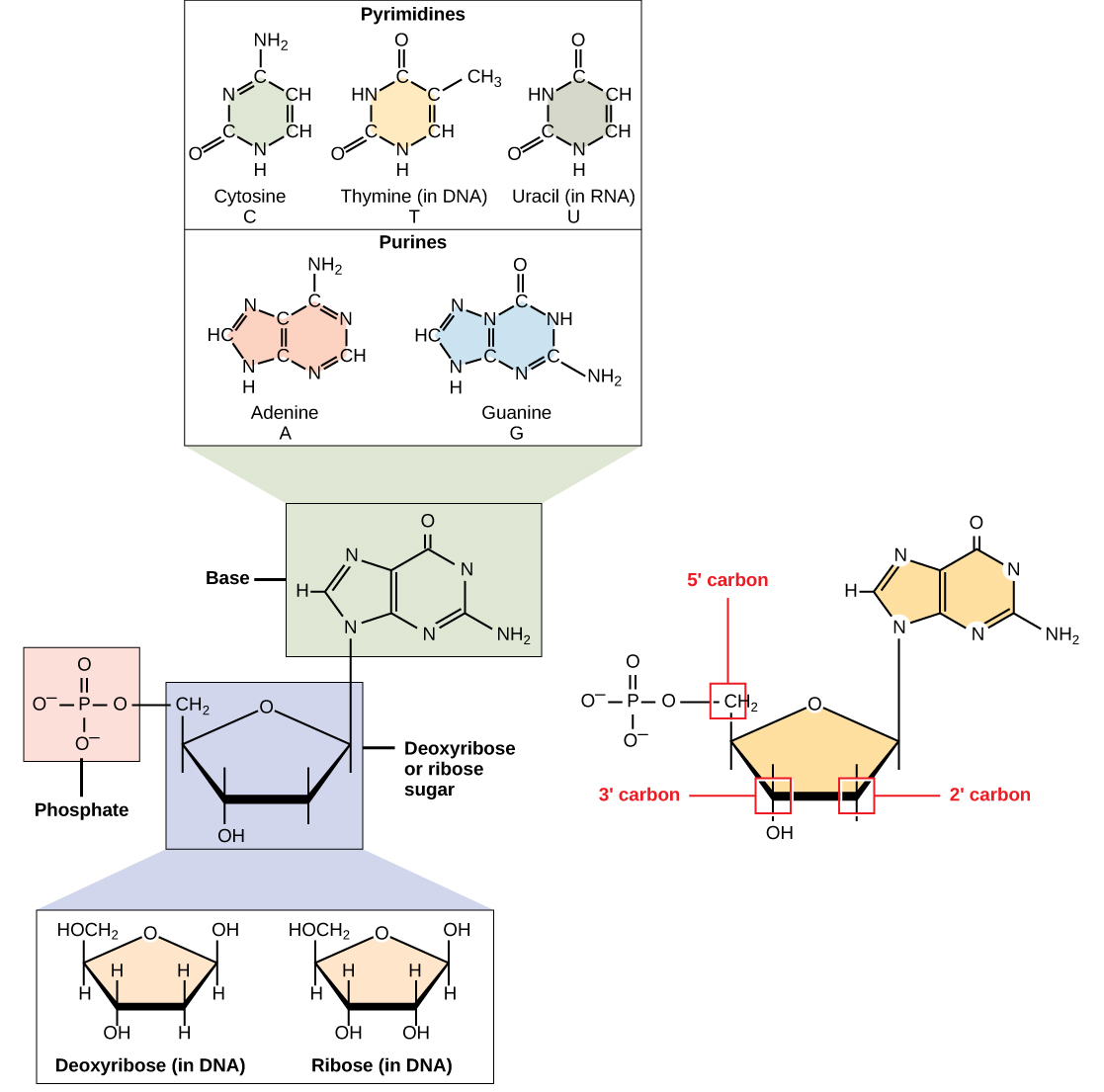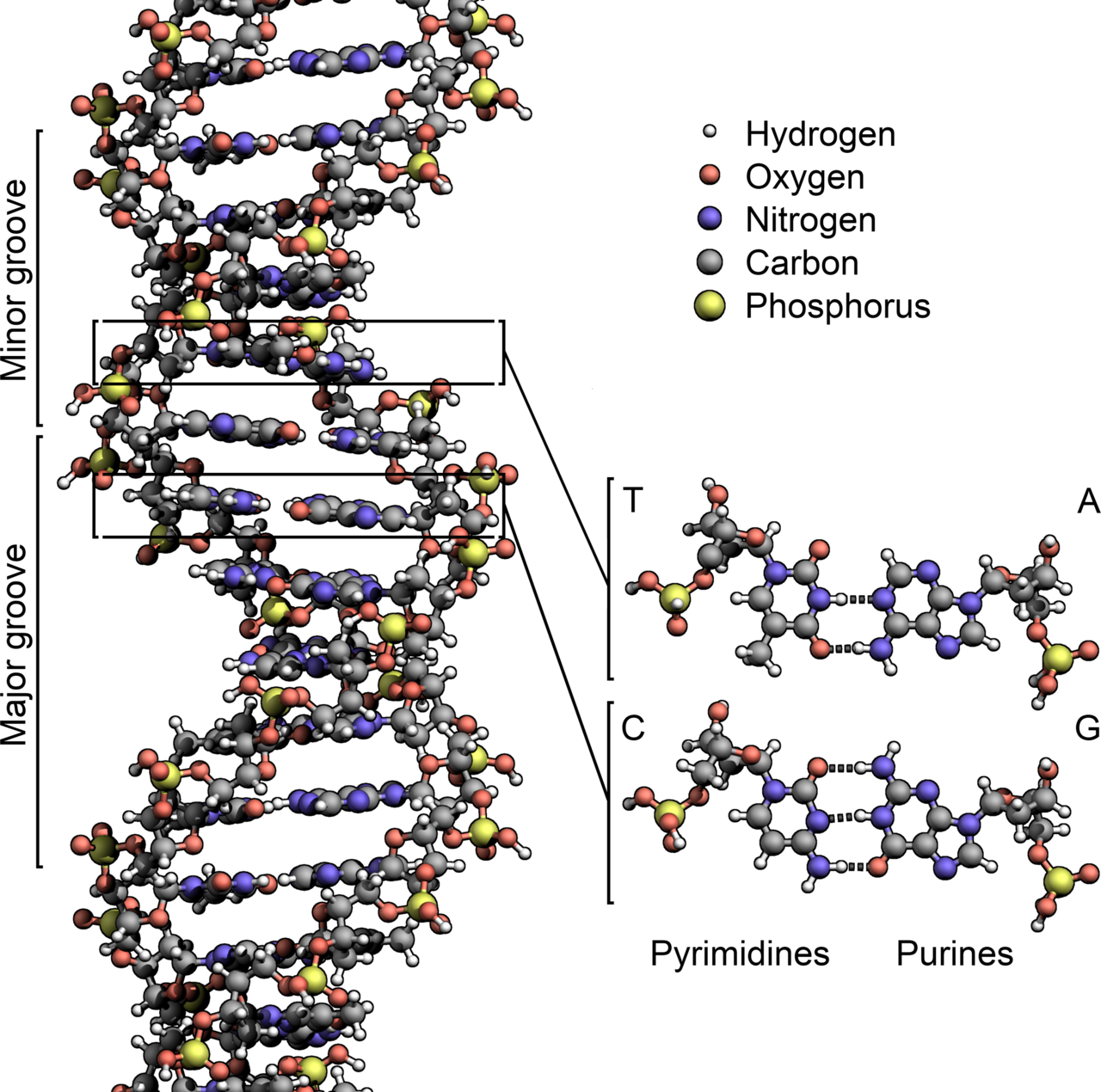DNA, RNA, Genes and Chromosomes
- Page ID
- 8999
skills to develop
- Explain the differences between RNA and DNA in terms of function
- Recognize the structure of DNA
- Explain the two functions of the genome
- Explain how DNA and genes are converted into proteins (the "central dogma")
- Differentiate between genotype and phenotype and explain how environmental factors influence phenotype
- Describe why DNA is packaged into chromosomes
Nucleic Acids
Nucleic acids are macromolecules that all life on Earth uses to hold its evolutionary memory. They carry the genetic blueprint of a cell in the form of deoxyribonucleic acid (DNA) and the instructions for the function of the cell in the form of ribonucleic acid (RNA). Chromosomes are composed of DNA arranged into genes and other non-coding areas. The genes are the blueprints for making various molecules that cells need to function, including enzymes. The non-coding areas are critical for influencing when genes are activated or expressed and play diverse other roles in cell function, some of which are not yet understood. DNA is a relatively stable molecule that is tightly controlled by the host cell. RNA is much more reactive than DNA. It plays diverse, reactive functions in cells. When most genes are expressed, they are translated into messenger RNA (mRNA) molecules, which are then transcribed into proteins. Some genes produce RNA molecules that play critical functions in cells, such as transcribing mRNA into proteins (ribosomal RNA or rRNA), transporting amino acids (transfer RNA or tRNA), and influencing gene expression (microRNA). RNA is so fundamental to basic cell functions that some scientists think that life originated in a “RNA world” with the transition from abiotic organic chemistry to life requiring the catalytic properties of RNA molecules (See https://www.khanacademy.org/science/ap-biology/natural-selection/origins-of-life-on-earth/a/rna-world for more information).
Although RNA is critical to cell function, it is a reactive molecule and does not provide a reliable memory system for inheritance in organisms. In contrast, the structure of DNA molecules makes them much less reactive, and they can be packaged into nested spirals that protect them from damage. Thus, DNA is a more reliable memory system for inheritance. It is used by all organisms (except some viruses – if they are organisms) to encode critical cell functions. Most of the DNA in cells is packaged into chromosomes that are copied when cells reproduce. However, some DNA is present in plasmids (small circular DNA molecules outside of chromosomes) and Eukaryotic organelles (e.g. plastids and mitochondria). The entire genetic content of a cell is known as its genome.
What are DNA and RNA?
Nucleic acids are made up of nucleotides composed of a nitrogenous base, a pentose sugar, and a phosphate group. The nitrogenous bases have 5 different structures and are the letters that compose the codes in DNA and RNA molecules. These bases include: adenine (A), guanine (G) cytosine (C), thymine (T) in DNA, and uracil (U) in RNA (figure showing the structure of the bases). DNA and RNA molecules consist of chains of nitrogenous bases bound together by their attached phosphate groups.

Figure Nucleotides: A nucleotide is made up of three components: a nitrogenous base, a pentose sugar, and one or more phosphate groups. Carbon residues in the pentose are numbered 1′ through 5′ (the prime distinguishes these residues from those in the base, which are numbered without using a prime ' notation). The base is attached to the 1′ position of the ribose, and the phosphate is attached to the 5′ position. When a nucleotide is added to a DNA or RNA molecule, the 5′ phosphate of the incoming nucleotide attaches to the 3′ hydroxyl group at the end of the growing chain. Two types of pentose are found in nucleotides, deoxyribose (found in DNA) and ribose (found in RNA). Deoxyribose is similar in structure to ribose, but it has an H instead of an OH at the 2′ position. Bases can be divided into two categories: purines and pyrimidines. Purines have a double ring structure, and pyrimidines have a single ring. Variations in the structures of these molecules affect their function, differentiating DNA from RNA and the reactivity of the molecules.
In DNA, two strands of nucleotides are paired together by hydrogen bonds between their bases in a very systematic way. A can bond with T, and G can bond with C when the two strands are oriented in opposite directions. The two strands only pair if their sequences of bases are complementary. For example, if the sequence of one strand is AATTGGCC, the complementary strand would have the sequence TTAACCGG. When each base is matched to its complement on the other strand, the two strands spiral around each other, creating a very stable (and famous) double-helical structure.

Figure DNA: The structure of DNA showing the details of hydrogen bonds (dashed lines) between complementary base pairs. Note that the yellow phosphate groups point upward on the right side and downward on the left side. The grooves are due to asymmetry in the spiral. (Figure credit: Zephyris (Richard Wheeler))
In contrast to DNA, RNA is single-stranded, and the nitrogenous bases are not necessarily paired with their complements. (U takes the place of T in RNA, bonding with A.) The bases are, however, reactive. If there are stretches of complementary base pairs elsewhere on the RNA molecule or on another RNA molecule, those segments will form hydrogen bonds, tying the two complementary parts together. When sections of RNA bind with each other, the RNA strand(s) folds into specific shapes, which affect how they catalyze reactions. The patterns of RNA base pairs determine how the strands fold, allowing them to perform different functions for the cells.
Management of DNA and RNA is critical for organisms to live and reproduce.
Genes
DNA is the genetic material responsible for inheritance and is passed from parent to offspring for all life on Earth. To preserve the integrity of this genetic information, DNA must be replicated with great accuracy, with minimal errors that introduce changes to the DNA sequence. A genome contains the full complement of DNA within a cell and is organized into smaller, discrete units called genes that are arranged on chromosomes and plasmids.
A gene is composed of DNA that is “read” or transcribed to produce an RNA molecule during the process of transcription. One major type of RNA molecule, called messenger RNA (mRNA), provides the information for the ribosome to catalyze protein synthesis in a process called translation. The processes of transcription and translation are collectively referred to as gene expression. Gene expression is the synthesis of a specific protein with a sequence of amino acids that is encoded in the gene. The flow of genetic information from DNA to RNA to protein is described by the central dogma (Figure 11.1.111.1.1). Each of the processes of replication, transcription, and translation includes the stages of 1) initiation, 2) elongation (polymerization), and 3) termination. These stages will be described in more detail in this chapter.

A cell’s genotype is the full collection of genes it contains, whereas its phenotype is the set of observable characteristics that result from those genes. The phenotype is the product of the array of proteins being produced by the cell at a given time, which is influenced by the cell’s genotype as well as interactions with the cell’s environment. Genes code for proteins that have functions in the cell. Although a cell’s genotype remains constant, not all genes are used to direct the production of their proteins simultaneously. Cells carefully regulate expression of their genes, only using genes to make specific proteins when those proteins are needed (Figure 11.1.211.1.2). Thus, their phenotype changes through time.

Chromosomes
DNA strands are packaged into chromosomes with proteins, which allow cells to control gene expression (and phenotypes), replication of the DNA, and separation of the genetic material into cells as they divide. Most (but not all) Bacteria and Archaea have circular chromosomes, with the DNA strands forming a continuous loop. These loops are often twisted up on themselves so the chromosomes make compact structures in the cells (https://www.nature.com/scitable/topicpage/genome-packaging-in-prokaryotes-the-circular-chromosome-9113/). The region in a cell with the condensed chromosome is called the nucleoid. Some DNA can also be housed in structures called plasmids that are more easily exchanged between organisms.
Eukaryotes organize their DNA differently. First, most of the DNA is encased in the cell nucleus, which is separated from the rest of the cell with a membrane. Within the nucleus, the DNA strands are packed into multiple linear chromosomes. DNA strands are wrapped around special proteins called histones (also present in some Archaea) and then folded into even tighter areas by additional proteins. The folding of the chromosomes and the details of the chemical structure of long chains coming off the histones strongly influence whether or not genes on the chromosomes can be expressed. Eukaryotes also have DNA in other parts of their cells, specifically certain organelles, including mitochondria and plastids (which include chloroplasts). The DNA in organelles (orDNA) is inherited from ancient bacteria that were the ancestors of these organelles. orDNA is packaged into their own chromosomes, whose structure varies among different organisms and even during development of a single organism. In general, orDNA structure is highly variable and poorly understood relative to nuclear DNA structure and replication (see https://www.frontiersin.org/articles/10.3389/fpls.2015.00883/full)
For all DNA, the structure of the chromosomes strongly influences how and when the DNA is active and can be copied.
Key Concepts and Summary
- Nucleic acids are molecules composed of three components. The details of these components affect the function and behavior of RNA and DNA molecules
- The sequence of nitrogenous bases in DNA and RNA provides the information recorded in the molecules.
- Double-stranded DNA has a helical structure in which bases are pared with their complements on the opposite strand.
- Genes consist of DNA sequences that code for the production of specific proteins.
- The genotype of a cell consists of all of its genes and remains constant. The phenotype of a cell consists of the functions a cell is capable of due to the expression of genes. Phenotype varies through time as gene expression changes in response to environmental and biochemical signals.
- Organisms organize their DNA into chromosomes. The structure of the chromosomes changes through time and affects which genes can be expressed.
More Information
Structure of bacterial chromosomes: https://www.nature.com/scitable/topicpage/genome-packaging-in-prokaryotes-the-circular-chromosome-9113/
Organelle DNA organization: https://www.frontiersin.org/articles/10.3389/fpls.2015.00883/full
Content on this page, including figures, has been derived from the Nucleic Acids chapter of General Biology (OpenStax) and Chapter 11.1 of Microbiology (OpenStax). Both are licensed under CC BY-NC-SA 3.0.

